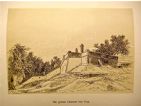
Springs and cisterns
Comparisson reports are under license of:

Lo que dice el Arxiduc:

“The number of cisterns is very significant in relation to the island’s size. There are 9 public cisterns and 160 private ones. They’re built more or less following the same design: in a paved area surrounded by a low wall which gathers the water or leads it to recipients beneath. From there the water is led out through one or several openings. Some public cisterns are fairly large. There are also 12 springs consisting of mixed salt and fresh water.”
Datos proyecto Nixe III:
Public cisterns are no longer used today as two desalination plants were built on the island in 2005 at Kaki Langada and Lakka, now supplying water to the rest of the island.
The cistern in Gaios is very similar to the one the Archduke found in his day, only losing 5 of the lower steps. We can also still see the canal leading the water to the cistern.
We also found cisterns inside the Agios Nikolaos fortress. One dates to the time of the British Protectorate, and the other is similar to the cisterns built on the island as of 1423.
 On the island of Panaghia the cistern includes a closed dome which serves to protect it.
On the island of Panaghia the cistern includes a closed dome which serves to protect it.
 There are private cisterns throughout the island. In this case, a wall was built on an estate but leaving the cistern outside.
There are private cisterns throughout the island. In this case, a wall was built on an estate but leaving the cistern outside.
Also worth noting is that locals built natural filtering systems at the entrance to the wells of many of these cisterns. These systems consist of, first, an iron grate generally to keep out larger waste brought in by the canal. The second filter consists of beach or river pebbles and the third, sand. The cisterns include, one, two or all three of these filtering systems.
In addition to their usefulness for the population, we should also note that these buildings were often very attractive, architecturally speaking.


















